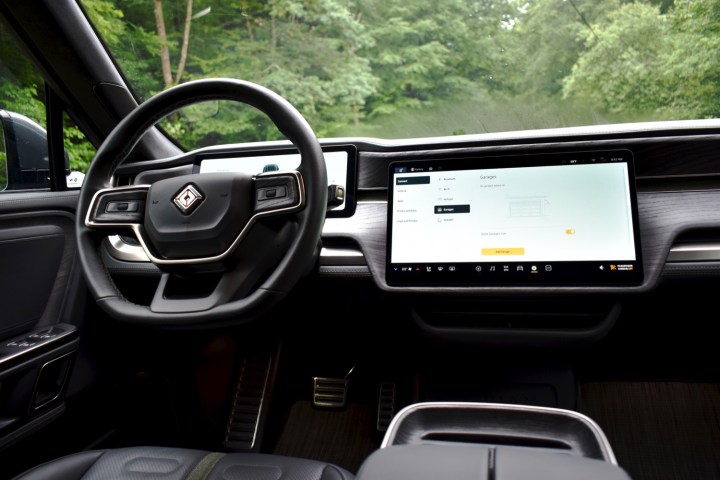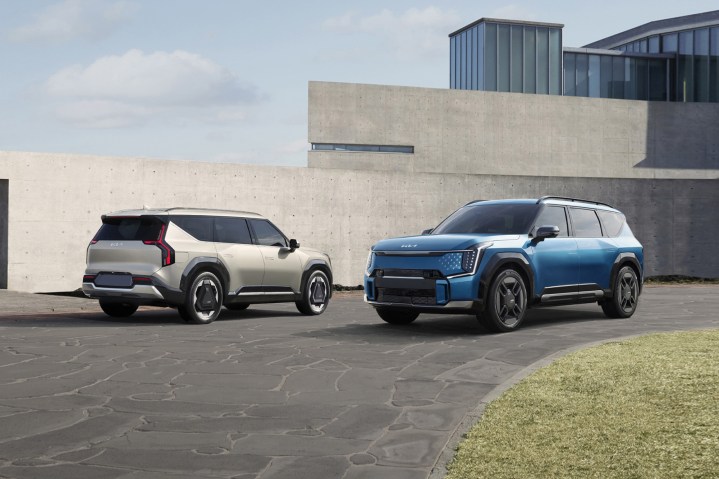While electric crossovers have become extremely popular, SUV-sized vehicles haven’t been quite as common. Sure, Tesla calls the Model X an SUV, but many customers think of a specific shape and size of car when they think of an SUV — and the Tesla Model X doesn’t really fit that. Now, however, actual electric SUVs are finally coming out — like the Rivian R1S and the Kia EV9.
The Rivian R1S may come from a lesser-known and smaller brand, but that certainly doesn’t make it worse. In fact, it could make the company more nimble, and more innovative. But, there’s still something to be said for the reliability of a well-known brand.
When it comes right down to it, which is better — the Kia EV9 or the Rivian R1S? Here’s everything you need to know.
Design
The Rivian R1S and Kia EV9 may have similarities in design, but as far as large SUVs go, they still look pretty different.

That all starts at the front. The Kia EV9 has what Kia calls the “Digital Tiger Face,” with angular headlights on the front and a mean-looking style. The roof slopes slightly towards the back, where more angular lights can be found.
The Rivian R1S is a different take on the SUV. A prominent light bar extends along the front, interrupted only by the oval headlights that have become synonymous with the Rivian name. On the back of the Rivian R1S, another light bar serves as the taillights for a decidedly more friendly take on SUV design than the Kia.
The EV9 is a handsome SUV, and a little more aggressive. But the Rivian is a little fresher and a little more modern. I actually don’t find one to be better — I love the look of both of them.
Winner: Tie
Interior and tech
Those vibes extend into the interior of the car. The interior of the Kia EV9 is very modern and high-tech, with dual screens at the front for instrument information and infotainment. The interior of the car is very comfortable too. The EV9 boasts three rows, with options for either six or seven seats, so there’s plenty of room for most families. Generally, however, apart from the dual-screen setup at the front, the EV9 offers a slightly more traditional take on interior car design.

The Rivian R1S is a little more interesting in interior design. The car also has two screens, however those include a much larger 15.6-inch center display with an infotainment system that’s powered by Unreal Engine — making for stunning graphics overall. Generally, most drivers find the Rivian R1S’ software to be easy to navigate and well-designed — and while the Kia EV9’s infotainment system isn’t bad, it’s not as modern as the Rivian’s. The Rivian R1S also offers seven seats.
While the EV9 is familiar and intuitive, the Rivian is more modern and innovative. While it may be a matter of personal preference, we’re handing this one to Rivian for its bold approach.
Winner: Rivian R1S
Performance
Under the hood, the cars have some similarities too — however one is slightly higher-performing than the other.
The Kia EV9 is available in three different variants, including two rear-wheel drive models (one with a 76.1kWh battery,and one with a 99.8kWh battery). While those won’t be quite as high-performing as the dual-motor model, they will offer a longer range. EPA range has yet to be released for the EV9, but Kia estimates that the car will offer up to around 300 miles of range. We don’t yet know how fast the EV9 accelerates.

The Rivian R1S is also available in three models — however even the base model is a dual-motor AWD model that delivers zero to 60 mph in 4.5 seconds. One step up gets you the Performance Dual-Motor AWD that drops zero-to-60 time to 3.5 seconds. Finally, the Quad Motor AWD delivers a huge 835 horsepower that results zero-to 60 in 3.0 seconds. At its lowest range, the Rivian R1S will get you 260 miles of range, while the longest-range model offers 340 miles.
While we don’t know acceleration specs for the EV9, even a Kia EV6 GT is slower than a top-tier Rivian, and Rivian boasts longer range.
Winner: Rivian R1S
Pricing and availability
There are some differences when it comes to pricing and availability for the Kia EV9 and Rivian R1S — namely, the fact that only the Rivian R1S is currently available in the U.S. The Kia EV9 will be coming to the U.S. soon, and it’s currently available in South Korea. When it does come to the U.S., it’s expected that the EV9 will start at around $55,000, ranging up to $70,000 — depending on the model.

The Rivian R1S is a slightly different story. The R1S is currently available to reserve, however, deliveries for newly reserved vehicles are expected to be toward the end of 2023, or the beginning of 2024. The Rivian R1S comes at a much higher price too — the base model is a relatively pricey $78,000, ranging up to $92,000 for the performance model.
Even without U.S. pricing announced, it’s clear the EV9 will be more affordable than the Rivian.
Winner: Kia EV9
Overall winner
So, what’s the better electric SUV? Well, the answer is clear — the Rivian R1S. The R1S offers a more modern take on design, better software, and it comes with all-wheel drive as the default.
But it’s perhaps a slightly unfair comparison. The fact is that while the R1S may be better, it’s also a whole lot more expensive. The Kia EV9 still offers a great design overall, a solid range, and a fast-enough acceleration. Sure, you’ll have to pony up for the all-wheel drive model — but not everyone will need it.



